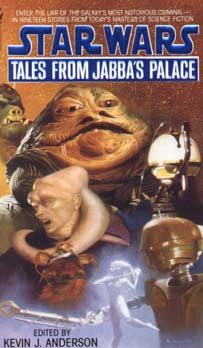Jabba the Hutt’s palace in “Return of the Jedi” was George Lucas’s “faster and more intense” answer to the cantina in “A New Hope.” Also benefiting from a second chance was “Tales from Jabba’s Palace” (1996), the follow-up to “Tales from the Mos Eisley Cantina” that had more room to play in, more screen time to draw from and more characters lurking in more shadows, even as editor Kevin J. Anderson got more ambitious with tying the stories together — something he toyed with in the previous volume.
“Tales from Jabba’s Palace” is a masterful work because — in addition to 19 fun stories, not one of which is a dud — Anderson weaves the tales together so nicely. Obviously, there are the touchstones from the movie — Luke fighting the Rancor, Jabba’s henchmen loading up the sail barge for the trip to the Sarlacc, etc. — but also, the writers weave a serial killer mystery into the bowels of the palace. And lurking even more in the shadows are the B’omarr monks — they don’t get a tale of their own, but they end up playing a major role (although, by book’s end, the creepiness of the monks removing people’s brains to be placed in jars is dulled by the fact that it happens to no less than five characters).
Since there are 19 tales, I’ll give my ranking of the top half — the 10 best:
1. “A Bad Feeling: The Tale of EV-9D9” by Judith and Garfield Reeves-Stevens — A lot of the tales achieve dark humor by using the tactic of an unusual perspective (let’s face it — every character in this book is unusual). This one is about a sociopath who loves torture: But since the droid EV-9D9 loves torturing droids rather than humans, nerves become pain receptors, blood becomes coolant, and so forth.
2. “A Boy and His Monster: The Rancor Keeper’s Tale” by Kevin J. Anderson — The editor sets the tone of dark humor with the opening tale, where he matter-of-factly chronicles the Rancor eating victims while still letting us sympathize with Malakili, who loves his monster unconditionally. A great image: Malakili enjoying a sandwich while sitting on his pet’s foot, even as gore from the beast’s meal rains down on his hood.
3. “And Then There Were Some: The Gamorrean Guard’s Tale” by William F. Wu — The funniest tale in the book reminds me of the “Buffy” episode “A New Man,” when we see that Giles is — to his own mind — speaking normally, but to everyone else he’s grunting and roaring like a monster. Wu applies a similar tactic, as a frustrated Gartogg says “good morning” to passersby only to have them cower in terror and wonder what he’s demanding of them.
4. “That’s Entertainment: The Tale of Salacious Crumb” by Esther M. Friesner — Yes, someone actually managed to put together a tale about everyone’s favorite Kowakian monkey-lizard; the key is the outsider’s perspective. Academician Melvosh Bloor is the audience surrogate trying to make logical sense of a crazy organization and place.

5. “A Barve Like That: The Tale of Boba Fett” by J.D. Montgomery — Daniel Keys Moran, who delivered the best entries in “Tales from the Mos Eisley Cantina” (Labria, the Devaronian) and “Tales of the Bounty Hunters” (Fett), says about 80 percent of this story is his and the rest is the editorial team’s, hence the fake author name. The main conflict is that Moran wanted the Sarlacc to be sentient and Lucasfilm said no. So he finds a way around it — a character who speaks for the Sarlacc even as he’s being digested — that allows the same story to be told, only clunkier. It’s not as good as his other two tales, but it’s still an essential Fett yarn as he experiences the terror of being trapped in its maze-like gullet before he escapes. Elements from this story would play into many other yarns, including Dengar’s tale in “Tales of the Bounty Hunters.”
6. “Out of the Closet: The Assassin’s Tale” by Jennifer Roberson — Even though he isn’t on screen in “Jedi,” Dannik Jerriko makes a return appearance after we got into his head in “Tales from the Mos Eisley Cantina.” Again, this is more driven by character than plot as we share head-space with an increasingly unstable killer who lusts after the “soup” of the Rebel heroes, and Jabba himself.
7. “Sleight of Hand: The Tale of Mara Jade” by Timothy Zahn — The Emperor’s Hand is another character who can’t be seen on screen despite being in the palace. Whereas Zahn’s “Tonnika Sisters” tale veered far from the cantina, this one works better as he keeps Mara within the palace, shows her believable not-quite-brushes with Luke, and chronicles her first-ever failure under the Emperor’s employ.
8. “Old Friends: Ephant Mon’s Tale” by Kenneth C. Flint — Is Jabba the Hutt all bad? Well, mostly. And yet we meet Ephant Mon, who is both a decent guy and Jabba’s friend. This tale tells how such an odd dichotomy is possible.
9. “Of the Day’s Annoyances: Bib Fortuna’s Tale” by M. Shayne Bell — Fortuna’s a master schemer, which is why he rose to the position of the Hutt’s majordomo. Here, we see the inner workings of those dark and cynical schemes as the story builds up to an ending that’s something the Twi’lek didn’t plan for.
10. “A Time to Mourn, a Time to Dance: Oola’s Tale” by Kathy Tyers — Whereas Fortuna is a Twi’lek who seeks to control his own destiny, Oola is a meek follower. A reader can feel Luke’s frustration as he tries to free Oola in Mos Eisley before she’s shipped to Jabba’s palace, but she just won’t go along with it. We know Oola’s ultimate fate is to be a Rancor snack, but Tyers makes the dancer’s last act an overdue brave one — a classic example of a familiar scene being infused with new meaning.
Even with 19 tales here, there are still many characters seen in the palace that don’t get their stories told (the same goes for “Tales from the Mos Eisley Cantina”). Sequels to these books would be most welcome, although such a thing is a long shot. Along the same lines, there has never been any talk of “Tales” books based on the prequels. Anyone up for “Tales of the Podracers,” “Tales from That Bar Obi-Wan Goes Into” or “Tales of Order 66?”
Well, to be honest, “Ben Quadinaros’ Tale,” “The Death-Stick Smoker’s Tale” and “Ki-Adi Mundi’s Final Tale” aren’t at the top of my wish list either (don’t get me wrong, though — I’d still buy the books). But that’s not necessarily a knock on the prequels; it’s more of a compliment to the evocativeness of two settings from the original trilogy. Chalmun’s cantina and Jabba’s palace inspired us as moviegoers, and they inspired the authors who penned the tales. It’s hard to name even one other movie that has such a delicious setting, and the “Star Wars” saga does it in two out of six movies. Not too shabby.

